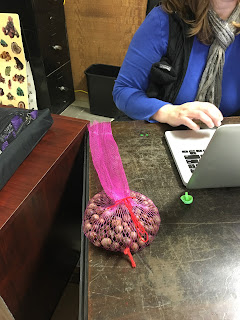 |
| A Maple Syrup sensory bin at Kalamazoo Nature Center. |
Have
you ever wondered why children are fascinated by the box their new toy arrives
in or is always trying to pick up a stick? The theory of Loose Parts by Simon
Nicholson explains it well. He stated, “In any environment, both the degree of
inventiveness and creativity, and the possibility of discovery, are directly
proportional to the number and kinds of variables in it.” In a child’s mind,
all those loose bits of string, sticks, and other “treasures” are really
components for building and creating.
Last
year, my youngest son had a simple request for his birthday present: “Sticks,
lots of sticks!” He knew and recognized the power of a simple loose part that
is actually included in the Toy Hall of Fame. To a child, a stick can be a
sword, a writing utensil, a fence post, a fairy wand, or more. The
possibilities are endless. Even adults get into the power of Loose Parts Play.
A couple of years ago, I was able to work alongside Patrick Dougherty who never
outgrew his affinity for sticks. Today, he makes twig sculptures all over the
world, using a whimsical approach in outdoor spaces. Just visit Fernwood
Botanical Gardens and Nature Preserve to see Take Five! and explore how he has
taken the theory of Loose Parts to the next level!
 |
| A Loose Parts Spider! |
I
experience the benefits on a regular basis as I host various activities and
learning experiences at Woodlawn Nature Center. We set up a Loose Parts Play
area that contains shelves of sticks, pinecones, tiles, fabric, blocks, acorn
caps, milkweed pods, and more. Children (and sometimes adults!) use these
various pieces to make creations that explore the natural world and help them
make sense of what they are learning.
One
girl had attended our Nature Preschool group on a Monday morning. Our topic was
birds. She returned on Friday, visiting the Loose Parts Play Area. In her
normal play, she built an anatomically correct bird out tree cookies,
pinecones, pipe cleaners, and sweet gum balls. She was able to tell us about
the beak, talons, wings, and body parts. In her normal play, she was making
sense of what she was learning and demonstrating her understanding of the
natural world around her through Loose Parts Play.
Additionally,
the Nature Explore nationally certified classroom at Woodlawn Nature Center has
areas to explore Loose Parts Play. Whether children are dragging long branches
to make their own Dougherty inspired twig sculpture, working together to lift a
tree cookie to build a ramp, or creating a fort out of long pieces of outdoor
fabric, children are able to use loose parts to create and build. This builds
and strengthens their connection to nature.
 |
| Educators work together to build a vehicle with loose parts at the Indiana Early Childhood Convention |
Benefits
of Loose Parts Play abound. Besides the imagination and creativity, loose parts
play promotes cooperation, experiences using all the senses, concrete examples
of abstract concepts, developmentally appropriate practices, ownership of one’s
learning, inclusive play, and moving, learning, and fun! This is learning!
Loose
Parts Play generally is open-ended. Items can be combined in many different
ways. There are no specific directions. The participants determine how the
materials will be used. The materials can be adapted in many ways. A Sweet Gum
ball may be a wheel on a car one minute, or the eye of a bird the next minute. Richard Louv suggested, “Nature is
imperfectly perfect, filled with loose parts and possibilities, with mud and
dust, nettles and sky, transcendent hands-on moments and skinned knees.”
What
are the components of Loose Parts? Almost anything! We typically use a
combination of natural materials and found objects or discards from industry.
Woodlawn Nature Center is always looking for donations of items that might fit
into these categories to help fulfill its mission of connecting others to
nature. Some examples include pinecones, sticks, tree cookies, wooden or wool
balls, sand, water, fabric, clay, picture frames, twine, nuts, mulch, stones,
straw bales, leaves, boxes, and blocks. As I shared the theory of Loose Parts
Play with local Indiana Master Naturalists, many remarked this is just how they
used to play as children. As electronics and overscheduled lives have crept
into our world, our children do not have as many opportunities for natural free
play like this.
Loose
Parts Play can be set up as a station, included in the classroom as a writing
prompt, used as an impromptu activity on the trail, as a pretest or assessment
of learning, as nature art, in a sensory bin, and more! The possibilities are
endless.
Want to learn more about Loose
Parts Play? Check out the Facebook Group Loose Parts Play for ideas and
suggestions. Educators and parents from around the world share how they are
using Loose Parts. I will also present “Loose Parts Play for Parents” at
Woodlawn Nature Center on February 26, 2016, at 6:30 pm. The cost is $3/person,
with proceeds going directly to operating costs of the Center. The parent
workshop will explore the theory of Loose Parts Play, explaining why children
often seem more intrigued with the box than the toys we buy them, looking at
open-ended toy options, and touching on how to use Loose Parts effectively in
the home environment. Reservations are appreciated by emailing
woodlawnnaturecenteronline@gmail.com.
Additionally, watch for upcoming
programs at Woodlawn Nature Center, such as Nature Inspired Tinkering in April,
Fairy Wings and Wild Things in May, Pop-Up Adventure Play and International Mud Day in
June, and our regularly scheduled nature play days! See Loose Parts Quotes and Loose Parts Worksheets on the blog!



















